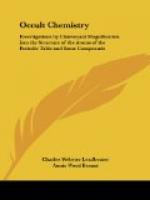According to the lemniscate arrangement, we should commence with hydrogen as the head of the first negative group, but as it differs wholly from those placed with it, it is better to take it by itself. Hydrogen is the lightest of the known elements, and is therefore taken as 1 in ordinary chemistry, and all atomic weights are multiples of this. We take it as 18, because it contains eighteen ultimate atoms, the smallest number we have found in a chemical element. So our “number-weights” are obtained by dividing the total number of atoms in an element by 18 (see p. 349, January).
[Illustration: PLATE V.]
HYDROGEN (Plate V, 1).—Hydrogen not only stands apart from its reputed group by not having the characteristic dumb-bell shape, well shown in sodium (Plate I, opposite p. 349, January), but it also stands apart in being positive, serving as a base, not as a chlorous, or acid, radical, thus “playing the part of a metal,” as in hydrogen chloride (hydrochloric acid), hydrogen sulphate (sulphuric acid), etc.
It is most curious that hydrogen, oxygen and nitrogen, the most widely spread gases, all differ fundamentally in form from the groups they reputedly head.[19] Hydrogen was the first chemical element examined by us, nearly thirteen years ago, and I reproduce here the substance of what I wrote in November, 1895, for we have nothing to add to nor amend in it.
Hydrogen consists of six small bodies, contained in an egg-like form (the outer forms are not given in the diagrams). The six little bodies are arranged in two sets of three, forming two triangles which are not interchangeable, but are related to each other as object and image. The six bodies are not all alike; they each contain three ultimate physical atoms, but in four of the bodies the three atoms are arranged in a triangle, and in the remaining two in a line.
HYDROGEN: 6 bodies of 3 18
Atomic
weight 1
Number
weight 18/18 1
I.—THE DUMB-BELL GROUP.
I a.—This group consists of Cl, Br, and I (chlorine, bromine and iodine); they are monads, diamagnetic and negative.
CHLORINE (Plate V, 2).—As already said, the general form is that of the dumb-bell, the lower and upper parts each consisting of twelve funnels, six sloping upwards and six downwards, the funnels radiating outwards from a central globe, and these two parts being united by a connecting rod (see, again, sodium, Plate I).




